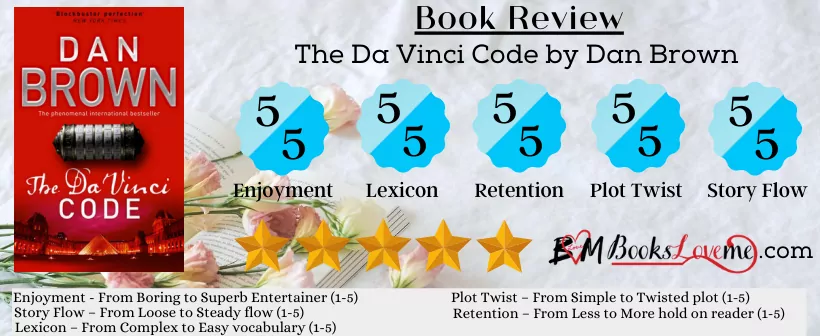The Da Vinci Code book is a mystery thriller by the master of thrillers himself, Dan Brown. It came out in 2003 and remained to be widely recommended, read, and studied.

It is the second novel featuring the famous symbologist Professor Langdon. The first was Angels and Demons, which came out in 2000. The book explores an alternative religious story.
It claims that the Merovingian kings of France were the descendants of Jesus Christ and Mary Magdalene. These were theories derived from ‘Templar Revelation’ by Clive Prince and other books by Margaret Starbird.
It invoked popular interest in the speculation involving the Holy Grail legend and the role of Mary Magdalene. The book, however, has been gravely criticized.
Much Christian domination accused it as an attack on the Catholic Church. Despite all of the criticisms, it went on to be one of the best-selling novels.
Around 80 million copies were sold by 2009, and translated into 44 languages. Columbia Pictures also released a film adaptation.
Table of Contents
About the Author- Dan Brown
Dan Brown is the author of several popular novels. His novels are translated to fifty-six languages and have oversubscribed virtually two hundred million copies.

In 2005, he was one of the 100 most influential people list on The Time magazine. They credited him with keeping the business enterprise trade afloat, spiking touristry in France and Rome, revitalizing interests in Symbolism and early Christian History, and way more.
He is a son of a scientist and a church instrumentalist grew up and studied in a secondary prep school. Even from a young age, the interaction between science and faith fascinated him.
He’s a graduate of Amherst faculty and Phillips Exeter Academy. He later came back to teach English before focusing his attention full time to writing. He lives in New England together with his yellow lab, Winston.
Some of his Works of Dan Brown
- Digital Fortress
- Deception Point
- Angels and Demons
- The lost symbol
- The Origin
Da Vinci Code Book Review:
The Da Vinci Code book doesn’t even need an introduction. As one of the most famous thrillers in English fiction and one of the best blockbuster film-adaptations, I’m sure you have heard of it before.
But for the ones who haven’t, this is a detailed book review, spoiler free, with just the right amount of content to get you to read it. Because if you don’t, then honey, you are missing out on the controversial yet best conspiracy-theory themed mystery of ALL TIME!
The story, written in much the same style as that of his previous works such as Angels and Demon, depicts the story of our favorite Harvard’s Professor of History of Art and Symbology, Professor Robert Langdon, finding himself on yet another trail of ancient symbols leading to a stunning historical truth.
While on business in Paris, Professor Langdon receives a late-night phone call. The elderly curator of the famous museum of France, the Louvre, has been murdered in cold blood inside the museum. He soon realizes why the police summoned him to the murder site.
Alongside the body, the police found a series of baffling codes and symbols. In this story, Professor Langdon and his side-kick, cryptologist Sophie Neveu, follow a massive trail of historical myths, facts, and logos to find a religious truth that can shake the foundations of Christianity itself
Dodging murderers and being tricked by allies follow Langdon and Neveu on this quest worthy of being compared to an Arthurian Legend in this book’s masterpiece.
List of characters:
Robert Langdon: The famous fictional professor at Harvard University is the main character in most of Dan Browns’ books, played by the legendary actor Tom Hanks in the movies.
Sophie Neveu: The cryptologist Langdon befriends and probably the only one he can trust.
BazuFache: The captain of the French National criminal-investigation police bureau. Langdon is his main suspect, so he spends most of his time in the book chasing him and Nevue.
Jérôme Collet: Fache’s second in command.
Bishop Aringarosa: The Spanish bishop and the worldwide head of Opus Dei.
Any more characters and I would be serving the spoilers on a silver platter. Read the book to find out who killed the curator and what the hidden truth is.
The Historical Aspects of The Da Vinci Code:
It is no surprising fact that The Da Vinci Code has tons and tons of events on symbology and History. The way it is put across to the readers will not fail to mesmerize and enchant them.
It is so beautiful, mystical, and crisp that it becomes very hard to separate the facts from fiction. The amount of research that the author had done before the book came into being is very clear.
It mentions some of the famous paintings of Leonardo Da Vinci, Mona Lisa and The Last Supper. The story is woven around these paintings.
It is a known theory that Da Vinci has hidden lots of meanings and secret codes in his works. Dan Brown uses that as the foundation of this book.
The Da Vinci Code is the perfect mixture of paranoid thriller, art history lessons, chase story, and religious symbology lectures. It succeeds in being a part of the mystery-thriller category and educational text.
Once you start reading this, you will find yourself researching famous historical sites and paintings such as The Louvre Museum and The Madonna on the Rocks. And once you’re done reading it, you will never see them as the same again, especially ‘The Last Supper.’
The Controversy and Religious Aspects:
As you may have heard, this book faced lots of criticisms when it was released. This portion is both a part of the review and a warning to Christian readers.
The book challenges the basic foundation on which Christianity is based. I was pretty much shocked when I read the part on what grounds Christianity was formed and how Paganism was erased.
My feminist self was screaming inside. When reading, you may feel attacked, but you must remember, it is just fiction. You should choose to believe what you want to, no matter how convincing Dan Brown makes it sound.
Dan Brown mentions the evidence he uses for the story, and some of them are real. But there are holes in the original story.
Meaning he wove an intricate tale out of those texts for his needs and created this amazing book. Upon research, you will find that the story is just that- a story or maybe not. Again, your choice.
That is the beauty of the book. It sounds so real, and the world-building is so mesmerizing that you wouldn’t want to leave…ever! After reading the book, the aftermath of the book haunted me.
I spent hours looking up all the references and secret societies he has mentioned. The author has also suggested that all descriptions of architecture, documents, and secret rituals are accurate.
This makes it even more haunting and thrilling to read it. This is one of those handfuls of books with enough twists and turns to have you gasping every few pages. You will simply not be able to put it down once you pick it up.
What I liked about the Da Vinci Code Book:
If you’ve read some of my previous reviews, you’ll know that I’m a sucker for a fast-paced novel. The Da Vinci Code progresses at breakneck speed, and I love it.
New information and astonishing plot twist every few pages? Check. A chase story involving police running after the wrong suspects? Check. Secret Societies and pagan rituals? Check.
A light budding romance, not too much but just enough? Check check check. I mean, what more do you want?
What didn’t I like about this book?
I’m not much for books that attack certain religions and call out their myths and legends as false or incomplete.
As I read through, I understood why some Christian readers forbade their followers from reading it.
But the sheer thrill of reading it overrode any doubts I had. I think that is why it became one of the best-selling novels.
When someone tells you not to do something, you just have to do it out of curiosity. It is simply a must-read book for everyone, whatever religion you are. Because books are for everyone, and no one can deny you the right to read.
The Di Vinci Code Quotes:
“Men go to far greater lengths to avoid what they fear than to obtain what they desire.”
“History is always written by the winners. When two cultures clash, the loser is obliterated, and the winner writes the history books-books which glorify their own cause and disparage the conquered foe. As Napoleon once said, ‘What is history, but a fable agreed upon?”
“Faith ― acceptance of which we imagine to be true, that which we cannot prove.”
“Telling someone about what a symbol means is like telling someone how music should make them feel.”
If you like it, I would suggest you to Murder on the Malabar Hill.
If you are into Fiction Books, you would love to see our collection.
